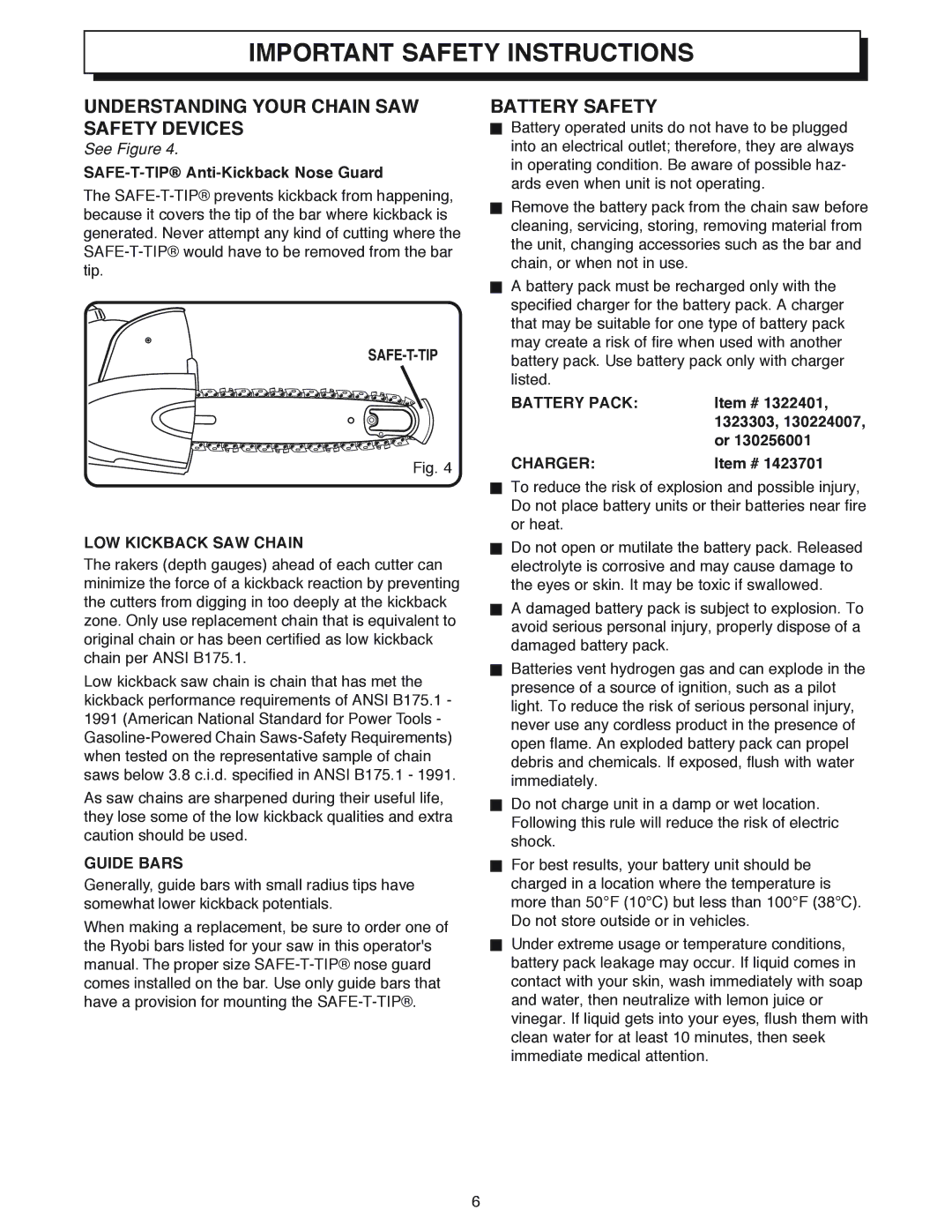
IMPORTANT SAFETY INSTRUCTIONS
UNDERSTANDING YOUR CHAIN SAW SAFETY DEVICES
See Figure 4.
SAFE-T-TIP® Anti-Kickback Nose Guard
The
Fig. 4
BATTERY SAFETY
■Battery operated units do not have to be plugged into an electrical outlet; therefore, they are always in operating condition. Be aware of possible haz- ards even when unit is not operating.
■Remove the battery pack from the chain saw before cleaning, servicing, storing, removing material from the unit, changing accessories such as the bar and chain, or when not in use.
■A battery pack must be recharged only with the specified charger for the battery pack. A charger that may be suitable for one type of battery pack may create a risk of fire when used with another battery pack. Use battery pack only with charger listed.
BATTERY PACK: | Item # 1322401, |
| 1323303, 130224007, |
| or 130256001 |
CHARGER: | Item # 1423701 |
LOW KICKBACK SAW CHAIN
The rakers (depth gauges) ahead of each cutter can minimize the force of a kickback reaction by preventing the cutters from digging in too deeply at the kickback zone. Only use replacement chain that is equivalent to original chain or has been certified as low kickback chain per ANSI B175.1.
Low kickback saw chain is chain that has met the kickback performance requirements of ANSI B175.1 - 1991 (American National Standard for Power Tools -
As saw chains are sharpened during their useful life, they lose some of the low kickback qualities and extra caution should be used.
GUIDE BARS
Generally, guide bars with small radius tips have somewhat lower kickback potentials.
When making a replacement, be sure to order one of the Ryobi bars listed for your saw in this operator's manual. The proper size
■To reduce the risk of explosion and possible injury, Do not place battery units or their batteries near fire or heat.
■Do not open or mutilate the battery pack. Released electrolyte is corrosive and may cause damage to the eyes or skin. It may be toxic if swallowed.
■A damaged battery pack is subject to explosion. To avoid serious personal injury, properly dispose of a damaged battery pack.
■Batteries vent hydrogen gas and can explode in the presence of a source of ignition, such as a pilot light. To reduce the risk of serious personal injury, never use any cordless product in the presence of open flame. An exploded battery pack can propel debris and chemicals. If exposed, flush with water immediately.
■Do not charge unit in a damp or wet location. Following this rule will reduce the risk of electric shock.
■For best results, your battery unit should be charged in a location where the temperature is more than 50°F (10°C) but less than 100°F (38°C). Do not store outside or in vehicles.
■Under extreme usage or temperature conditions, battery pack leakage may occur. If liquid comes in contact with your skin, wash immediately with soap and water, then neutralize with lemon juice or vinegar. If liquid gets into your eyes, flush them with clean water for at least 10 minutes, then seek immediate medical attention.
6
